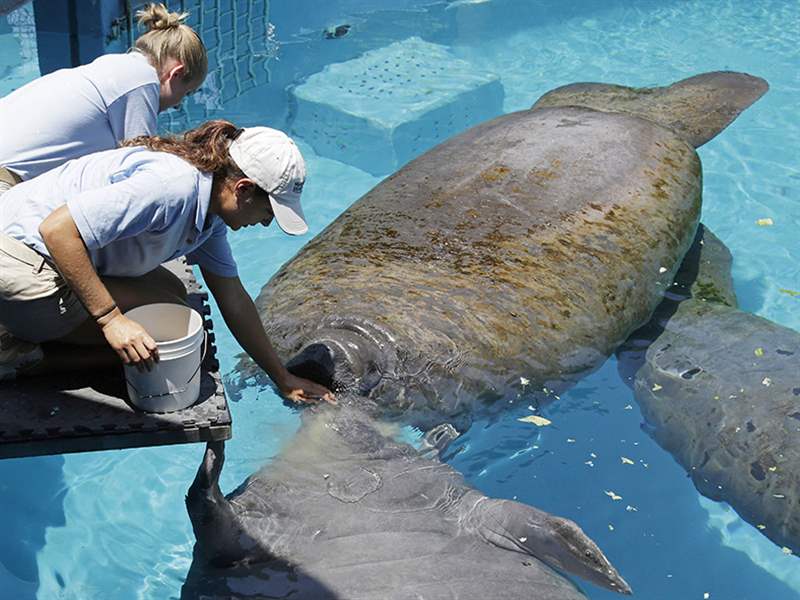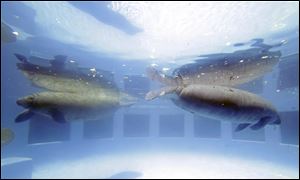
Florida's gentle giants recovering
Status as endangered species could be lifted for manatees
8/31/2014
Miami Seaquarium caretaker Joelle Palmer, foreground, and intern Ally Levy feed the manatees. Biggest threats to manatees in the wild are boat propellers, cold water, and toxic algae blooms.
ASSOCIATED PRESS

Miami Seaquarium caretaker Joelle Palmer, foreground, and intern Ally Levy feed the manatees. Biggest threats to manatees in the wild are boat propellers, cold water, and toxic algae blooms.
MIAMI — As they do whenever they visit Florida, Greg Groff and his young daughter stopped by the manatee pool at Miami Seaquarium, where the marine mammals placidly swim in circles.
They noted the pink scars and disfigured tail on one manatee, damage from a boat propeller that left the manatee unable to survive in the wild.
Florida’s manatees need even more stringent protections than their listing on the federal endangered species list, Mr. Groff said, adding that boaters should go elsewhere if they don’t like speed limits where manatees swim.
“There’s plenty of places they can go faster,” the Chicago man said. “They can go out in the middle of the ocean if they want to go much, much, much quicker, and you won’t have to worry about them running the manatees over.”
His comments represent the environmentalist and general public side of an ongoing fight with boaters, businesses, and conservatives over whether the manatee should retain its 1967 federal listing as an endangered species, the most protective classification.
The U.S. Fish and Wildlife Service is reviewing whether the manatee should be reclassified as a “threatened” species, which would allow some flexibility for federal officials as the species recovers while maintaining most of the protections afforded to animals listed as endangered.

Manatees swim at the Miami Seaquarium in Key Biscayne, Fla. The U.S. Fish and Wildlife Service is reviewing whether the manatee should be reclassified as a ‘threatened’ species, which would allow some flexibility for federal officials as the species recovers while keeping ‘endangered’ protections.
As part of the review process, the agency is seeking public comment on its finding that a petition to reclassify the manatee has merits.
The deadline is Tuesday. A decision on whether a change is warranted won’t be made until the agency completes its review, which could take a year.
Manatees, also known as sea cows, are vegetarian giants that average nearly 10 feet long and 2,200 pounds and live near the shore and in coastal waterways around much of Florida.
The animal’s biggest threats are boats, cold water, toxic algae blooms, and fishing debris like discarded lines and ropes.
“If we come to the end of this and decide reclassification is warranted, it’s good news because it means the manatee is recovering and no longer on the brink of extinction,” agency spokesman Chuck Underwood said.
Critics of the manatee’s current endangered listing say manatees are important to the state’s tourism industry, but the species has recovered sufficiently over the last 47 years to be reclassified.